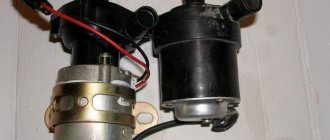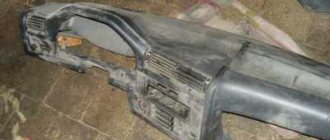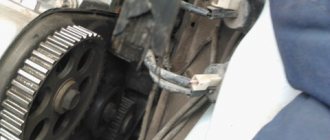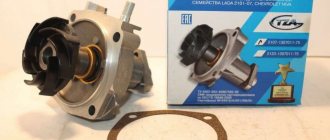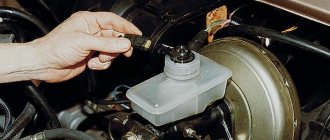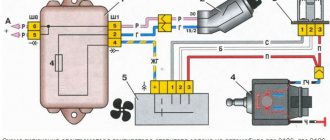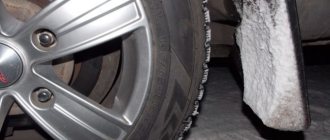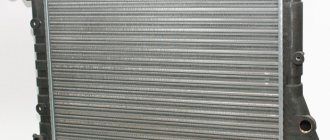Replacing pipes
And when it’s time to change the heater radiator pipes on your VAZ 2109, don’t be afraid to do the replacement yourself. First of all, it is important to know where the stove radiator and its pipes are located. So, the heater radiator is located on the right heater casing (that is, to the right of the panel of heater control levers), direct access is blocked by the dashboard console. The price of the pipes themselves is a pittance, but for replacement at a service station they will demand a tidy sum, why? Now you will see for yourself. There are two ways to replace pipes (the methods are also suitable for replacing a stove radiator):
- The first - (the so-called classic) is carried out in accordance with the instructions (manual) for the operation, maintenance and repair of the VAZ2109.
- It involves removing the dashboard and draining the fluid from the engine cooling system.
- The second is simpler (folk), does not require complex manipulations
- In our article we will consider both methods so that you can choose the most convenient one for you.
Classic way
It is worth noting right away that it is quite labor-intensive and will take quite a lot of time. You will need a lot of patience and care (as mentioned above). The most difficult part is removing the instrument panel and installing it, as it is much more difficult to get the instrument panel into place correctly.
Tool
- Coolant drain container
- Screwdriver Set
- Head with a wrench to unscrew the steering wheel
Let's start in order:
- Removing the terminals from the battery
- With the heater tap open, drain the coolant by unscrewing the drain plugs located on the radiator and cylinder block (into a substitute container)
- Removing the decorative trim from the steering wheel
- We unscrew the nut securing the steering wheel so that its end is flush with the end of the steering column shaft.
- The steering wheel is seated very tightly on the shaft splines, so for safety reasons it is not recommended to completely unscrew the nut securing the steering wheel: with a sharp impact, it will jump off the splines and can cause injury
- Be sure to mark the location of the steering wheel in relation to the shaft
- Knock the steering wheel off the shaft splines with sharp blows of your hand.
- Now you can finally unscrew the nut and remove the steering wheel
- Unscrew the six screws securing the lower steering column casing
- Remove the lower casing from the steering column, as well as the lining of the ignition switch (lock)
- Then remove the upper casing from the steering column
- Loosen the bolt securing the base under the steering switches
- We remove the base from the shaft, disconnect the blocks with wires (there are two of them) from the contacts of the car horn
- Now we disconnect the block with wiring from the windshield wiper and washer switch lever
- It is recommended to mark the terminals with wiring before disconnecting. This will help you avoid confusion during assembly and save time.
- Disconnect the block with wiring from the headlight and turn signal switch lever
- Pull the carburetor choke control handle (aka “choke”) towards you so that the draft comes out, remove the handle from it
- Unscrew the two screws securing the dashboard console trim
- Removing the cover from the console
- Remove the cigarette lighter from the socket
- We take out the ashtray from the nest by pressing on the plate to extinguish cigarettes
- Remove the handle that switches the heater fan
- Then we remove the three knobs that control the stove and hook them with a screwdriver
- Disconnect the block with wiring from the heater fan switch, located under the heater control panel
- Disconnect two wires from the contacts of the lamp illuminating the heater control panel
- Remove the headlight direction adjustment handle, just pull it towards you
- Now remove the instrument cluster lighting switch knob
- Unscrew the nut securing the instrument lighting switch
- Unscrew the nut securing the headlight hydraulic corrector
- We push the hydraulic corrector for headlights and the instrument lighting switch inside the panel
- Remove the side nozzles located on both sides of the dashboard using a screwdriver
- Unscrew one screw securing the trim on both sides of the dashboard
- Using a screwdriver, use a screwdriver to remove the exterior lighting switch.
- Disconnect the block with wires from the switch. Push the block inside the dashboard
- We use a screwdriver and remove the socket intended for radio equipment. If you have radio equipment installed on your VAZ 2109, remove it first
- We remove radio equipment according to the manufacturer’s instructions
- Then unscrew the screw securing the trim to the dashboard
- We insert two screwdrivers so that we can bend the plastic latches
- Raising the dashboard trim
- Disconnect the wiring harness from the cigarette lighter
- Disconnect the block with wiring from the block for lighting the cigarette lighter
- Disconnect the block with wiring from the lamp illuminating the hazard warning switch
- We disconnect the block with wiring from the hazard warning switch, and finally remove the dashboard trim
- Gently press down and remove the speaker cover located on the left side of the dashboard. Be careful - latches break easily
- Disconnect the block with wiring from the heated glass switch
- Remove the block from the rear fog lamp switch
- Unscrew the two screws securing the instrument cluster
- We take out the instrument cluster from the dashboard, unscrew the nut securing the cable from the speedometer and disconnect it
Removing the instrument panel
Attention: Disconnect the connectors with wiring for additional equipment, if installed on your car.
- Disconnect the red block from the instrument cluster
- Then disconnect the block from the control system
- Disconnect the white block from the instrument cluster
- Disconnect the ignition switch block from the ignition relay
- Disconnect the ground wire of the ignition relay
- Disconnect the control lamp block for opening the air damper
- Unscrew one screw from the lower mounting of the dashboard on both sides
- Disconnect the drawer light lamp block
- Unscrew the two screws securing the heater control panel and lower it down
- Unscrew the two screws securing the air damper guide rod to the dashboard
- Unscrew two screws from the upper mounting of the dashboard on both sides
- We use a screwdriver and remove one plug at a time from both sides of the dashboard.
- Unscrew one screw from the side mounting of the dashboard on both sides
- Unscrew the screw of the central fastening of the instrument panel
- Remove the dashboard
- After replacing the pipes or the heater radiator itself, we assemble the panel in the reverse order
- After installing the panel, we check the operation of the switches and all devices to ensure they are connected correctly
Let's return to the heater radiator pipes; we have already removed the panel:
- We disconnect the plastic clamp located on the right side of the heater, which holds the damper rod that heats the windshield
- Loosen the clamps and disconnect both pipes from the heater tap from inside the car under the dashboard
Loosen the clamps and remove the pipes
- Then loosen the clamps and disconnect both pipes from the heater valve located in the engine compartment (if you are going to remove the heater valve, otherwise skip it)
Disconnect the pipes in the engine compartment
- We replace the pipes with new ones, it’s better to replace the clamps right away, even if they are still suitable, it’s better not to risk it
- If necessary, you can unscrew the three screws securing the radiator to the stove
- And, raising the rod, pull out the heater radiator to check its condition and replace it
This is exactly how craftsmen are required to replace the VAZ 2109 stove pipes (replacement pipes) in service centers and auto repair shops. For owners who decide to do this work with their own hands, it is necessary to take into account that it will take 4-6 hours
"Folk" way
Folk craftsmen - these are brave and very desperate craftsmen - offer a much less labor-intensive method. The bottom line is that replacing the stove pipes (and the stove itself) is done without draining the coolant and without dismantling the instrument panel. The tools you will need are a set of screwdrivers, rags and a container (small) to drain the liquid from the pipes. In this case, replacing the heater radiator pipes is carried out according to the following scheme:
- Removing the terminals from the battery
- Close the heater tap
- We remove the right front seat (to make it easier to do the work)
- We unscrew the two screws securing the dashboard on the right side, and one screw located in the glove compartment, then, pulling the dashboard towards you, we place a wooden block
- Now there is a gap on the side of the passenger seat and you can get to the pipes and to the heater radiator itself
- Lay a rag on the floor of the cabin and prepare a container to collect the coolant
- Which will spill from the radiator and pipes
- We loosen the clamps of the pipes (photo above) and carefully, one by one, remove them from the radiator, replacing the container. 200 - 300 grams of coolant will drain into it
- Replace the pipes with new ones, and change the clamps, just in case.
- If necessary, unscrew the three bolts that secure the radiator to the stove and pull it down to the right
- We install the pipes and the new radiator in the reverse order.
Here are both methods, choose the one that suits you, and also watch a video on this topic.
How to independently replace the stove on a VAZ-2109
The main criterion for comfort in a car in winter is a working stove, and it is very unpleasant when it breaks down at the most inopportune moment. Most often, problems with the stove are associated with replacing the radiator, as it can either leak or become clogged. Of course, you can turn to a car service for help, but despite the fact that the process of replacing a radiator is quite a painstaking task, you can do it yourself and save a decent amount. You will learn how to remove and replace the stove on a VAZ-2109 with a high and low panel from our article.
Features of the fan and thermostat VAZ 21093, 2109, 21099
The electric fan includes an electric motor and a four-blade impeller, the blades of which have a variable angle of inclination and pitch to reduce noise levels. To increase efficiency, the VAZ fan system is equipped with a casing attached to brackets.
The electric fan is mounted on rubber bushings. The fan is triggered by a signal from a sensor installed in the radiator tank. In this case, the contact closure temperature is approximately 99'C, and the fan shutdown temperature is 94'C.
The system thermostat provides priority warming up of the engine and regulates the thermal regime. The optimal coolant temperature is within 90-98'C. The thermostat includes a body and a cover, rolled together with the valve.
Choosing a new radiator
The first sign of a high-quality radiator is its packaging and warranty service card. Counterfeits are usually sold in simple plastic bags. Proven radiators that you can safely buy and install on your car are products (Kraft).
Low panel
Before you start disassembling the dashboard to get to the radiator, you will need to drain the coolant. If it is still good, then after replacement it can be filled back in or replaced with a new one, otherwise. You will need:
- socket head 10;
- ratchet handle;
- extension cord more than 10 centimeters;
- deep head 10.
The heating system radiator is located at the passenger's feet. To remove it, unscrew the hoses that are held on the clamps and unhook them from the radiator. But be careful, as residual coolant may leak and ruin the interior. Therefore, prepare a container and a rag for the cooler in advance to avoid unpleasant consequences.
Then unscrew the 3 screws that hold the radiator to the heater body and the cable that regulates the windshield defroster. Then take it out and replace it with a new one.
Reassemble everything in reverse order and fill with coolant. Check the operation of the heater; if there is no heat after switching on, then most likely the system is airy and excess air needs to be released. To do this, remove the cap from the expansion tank and compress the cooling system pipes.
There is another interesting way to release excess air. To do this, place the car at the foot of the hill, but with the front of the car slightly raised, and apply the gas.
High panel
Removing the radiator on a VAZ-2109 with a high panel is done differently than with a low one. To do this, of course, you can disassemble the dashboard, but it is not necessary. Here's how to change it yourself:
- Open the hood and remove the heater casing. Unscrew the two screws that hold it in place.
- Lower the driver's seat all the way, you can also remove the steering wheel, but some people manage not to do this.
- Lie down on the driver's seat and open the positive block under the steering wheel and unscrew the nut that holds the heater ground wire.
- Then remove the radiator from under the hood. To make it easier for yourself, move the left corner a little.
- Installing a new radiator is done in the reverse order.
Scheme and design
In order to promptly determine the malfunction, check or replace the thermostat, you must first understand its circuit and design elements.
The scheme presented above is deciphered as follows.
Item number
| 1. | Inlet pipe coming from the radiator |
| 2. | Rubber insert |
| 3. | Heat sensitive solid filler |
| 4. | Bypass valve spring |
| 5. | Inlet pipe coming from the engine |
| 6. | Bypass valve |
| 7. | Outlet pipe going to the pump |
| 8. | Main valve spring |
| 9. | Main valve |
| 10. | Pipe coming from the expansion tank |
| 11. | Piston |
How to replace pipes on a VAZ-2109
It is also difficult to replace the heater pipes yourself, but it is possible. The price of the parts themselves is low, but you can pay quite a decent amount to replace them at a car service center.
There are 2 methods for replacing pipes in a heating system; usually they are changed at the same time as the radiator:
- The classic method is based on the instructions for operation, maintenance and repair of the VAZ-2109. It was described above. To replace the pipes, you need to remove the dashboard and drain the coolant.
Then replace the pipes with new ones, and it is also important to replace all the fastening clamps. Then reassemble the stove and put back the dashboard.
- The second method is much simpler, it is also called folk.
There is no need to drain the coolant or disassemble the dashboard.
Progress
- Disconnect the terminals from the battery.
- Close the heater tap.
- Remove or fold down the front right seat.
- Unscrew 2 screws on the dashboard on the right and 1 in the glove compartment and pull the dashboard towards you, place a block in the resulting gap to fix it.
- Through the gap that appears, you can get to the pipes and the heater radiator.
- Place a rag on the floor so that when removing the pipes, residual coolant does not stain the floor.
- Loosen the pipe clamps and remove them one by one from the radiator.
- Replace the pipes and clamps with new ones.
- The heater is connected in the reverse order.
Replacing the pipes and heater radiator in the interior of a VAZ-2109 is a rather long and painstaking procedure, but it can be done independently. The main thing is to check the operation of the stove immediately after the procedure and eliminate all defects. Then, after the work is completed, your car will again delight you with warmth during harsh winter trips.
Modernization of the VAZ 2109 heater
Those who like to “tinker” with cars and experiment can carry out a small modernization of the crane in the old “old-fashioned” way. This will require a ball valve with an angled handle. The sequence of actions will be as follows:
- 1. Drain the coolant;
- 2. Unscrew the plug in the tap and pull out the valve. It won't be useful anymore.
- 3. A 3-kopeck USSR coin will be suitable as a new plug. It will need to be inserted into the “glass”;
- 4. Screw in the plug;
- 5. Under the hood, cut off the heater pipe and install a water tap;
- 6. Tighten the clamps on both sides;
- 7. Pour in antifreeze;
- 8. Check the system.
How to check the condition of the VAZ-2109 pipes
Ideally, an inspection hole is needed to inspect the machine. In a garage this is not always possible, so craftsmen came up with another way out of the situation - they installed the VAZ-2109 on an overpass. You will also need a powerful jack; the car is placed on reliable supports.
To inspect the condition of the VAZ-2109 cooling system, stock up on the following tools:
- a lighting fixture with a protective cap that prevents injury from fragments of a broken lamp in case it falls;
- antifreeze to top up the fluid in the expansion tank to the maximum level.
Follow the step-by-step instructions and the test will be completed without any difficulties:
- Disconnect the negative terminal from the battery.
- Lay plywood or a thick sheet of cardboard on the flooring.
- First inspect the engine compartment, it is important to understand that the temperature of the cooling radiator and engine is equal to the air temperature.
- Evaluate the tightness of the connections of the pipes on the fittings that approach and extend from the radiator.
- The fit of the expansion component to the thermostat must also be carefully checked and felt by running your palm along the bottom of the connections. If the tightness leaves much to be desired, liquid is released.
- Tighten the clamps properly, but do not over-tighten, otherwise you may damage the pipe.
- Lie down on the cardboard placed under the VAZ-2109 and inspect the pipe along with the incoming pipe of the water pump. The hoses responsible for the interior heating system are also important.
- Pay attention to the pipes under the hood.
- Do not go past the rubber channels adjacent to the carburetor.
- Tighten the radiator drain plug and antifreeze temperature gauge securely.
Reasons for the release
The first step is to figure out why the coolant is being thrown out of the expansion tank.
- Wear of CO elements. In particular, we are talking about pipes and connecting hoses. They are constantly exposed to high pressure and temperatures. Therefore, over time, their wear and tear is a completely natural phenomenon. As a result, antifreeze begins to be thrown out.
- Low quality components. If natural wear and tear is typical for used cars and cooling systems that have been in operation for quite a long time, then when using low-quality components, even on a completely new or updated cooling system, serious problems can arise. An example is simple burrs on the neck of the expansion tank. Because of them, the lid does not fit tightly enough, which leads to a gap and the release of antifreeze.
- Expansion tank. Alas, the quality of the plastic from which expansion tanks for the VAZ 2109 are made today leaves much to be desired. Because of it, the plastic simply bursts under high pressure.
- Faulty engine. If the engine itself is not working correctly, the coolant may boil. This leads to damage to the thermostat, radiator, and pump.
From this we can conclude that the quality of the CO directly depends on the technical condition of the car and the quality of the components used.
Coolant emission
Signs of coolant emission
It is important to understand that coolant can be thrown out not only through the expansion tank cap, but also inside the system. It is important to monitor the condition of the CO and identify signs of a leak in time.
Antifreeze evaporates very quickly, so traces of it are not always visible.
- If coolant is released through the reservoir, puddles immediately form under the car.
- If liquid enters the cabin due to a malfunction of the CO, this can be determined by the smell. It has a sweetish tint.
- Antifreeze also often leaks into the engine system. Such a breakdown is determined by white smoke emanating through the exhaust pipe.
- The most unpleasant and dangerous situation is the release of antifreeze into the engine crankcase. If this happens, a white emulsion will appear on the surface of the oil filler cap.
- Periodically checking the space under the timing belt cover will determine whether the pump has failed. If yes, then you will find high humidity there.
Signs of boiling
If there are problems with the engine, antifreeze may simply boil in the CO
There is nothing good about this, so it is important to detect the malfunction in time. There are five main signs of coolant boiling:
- The temperature gauge jumps to 130 degrees;
- White foam appears at the filler neck;
- The engine stops working properly;
- The coolant level in the expansion tank rises sharply;
- White smoke comes out of the exhaust pipe.
Dismantling the worn-out cooling system of the VAZ-2109
If the coolant hoses are not in perfect condition, you will have to replace not only one worn component, but the entire system.
To install new parts, you need to dismantle the old ones.
Do-it-yourself dismantling of the cooling system consists of the following steps:
- Remove the cap from the expansion tank.
- Unscrew the heating valve inside the VAZ-2109, rotate the lever clockwise until it hits the end point.
- Remove the crankcase protective part by carefully unscrewing the fasteners.
- The coolant is drained into a prepared container with a volume of up to 8 liters. To do this, it is convenient to use a metal canister - it is easiest to drain antifreeze from it back into the VAZ-2109. Clean the area near the radiator drain plug and cylinder block, making sure that no dirt gets into the antifreeze. Place the container under the radiator.
- When the antifreeze is drained, tighten the plugs located on the radiator and housing.
- Replacing cooling pipes in a VAZ-2109 also involves dismantling work inside the cabin. Unscrew the bolts securing the instrument panel, get rid of the passenger and driver's seats - you can move them as far back as possible.
- Disconnect the clamps connecting the transmission tubes and provided for filling new antifreeze from the heater tap. It is located between the engine compartment and the passenger compartment.
- If they are pulled out, remove the rubber pipes by turning them on different sides. The parts have to be replaced, so they need to be trimmed with a sharp knife. Do not pull with force, otherwise you may damage the metal fixation of the fittings.
- Using a flathead screwdriver, remove the valve located in the engine compartment.
- Using pliers, release the holder from the heater tap drive rod.
- Clean the faucet and blow out the inside with a pump.
- Remove the pipes gradually, you need to dismantle everything coming from the engine and radiator. Remember how they were fixed - at the stage of installing new components, this will help to install them back quickly and correctly.
Installing an additional pump
The main negative quality of the basic heating element of the VAZ-2109 is its low efficiency at idle speed. This problem can be solved by installing an additional pump (additional pump) in the cooling system.
Purpose
By installing an additional pump 09, you can increase the efficiency of the stove at idle speed. The base heater blows warm air at idle, and hot air only when driving. This means that fluid circulation in the engine cooling system is poor. Installing an additional pump makes the coolant move much faster, including at idle, therefore, during a stop, hot air will blow from the stove, and not warm as before.
Which additional pump is better to choose?
The most common and proven options are additional pumps from GAZelle or Bosch. These elements do not have any problems with leakage.
Installation of an additional pump from a GAZelle on a VAZ-2109
You will need:
- Pump for GAZelle
- Relay. You can take a relay with normally open contacts 2105, 2108 - starter or ignition relay and bridge contacts 30 and 86.
- Reinforced hose.
- Cooling.
- Several clamps.
Progress
- Wait for the antifreeze to cool completely and drain it.
- Unscrew the 4 top screws on the pump, where the impeller is located, and coat the rubber gasket with sealant.
- Secure the pump to the studs near the battery.
- Disconnect the coolant wire hose to the heater from the outlet pipe of the cylinder head and connect it to the horizontal pipe of the pump.
- Connect the hose of the connected S-shaped hoses (located in the cabin between the tap and the radiator) to the vertical branch pipe.
- Connect the second end to the head of the block, in the previously removed place of the base one.
- Pull all the clamps and do not forget to tighten the drain plug in the block.
- Fill the coolant to the maximum and check for leaks.
- If necessary, tighten the clamps.
- After running the engine for half an hour, bring the antifreeze level to normal.
Scheme for installing an additional pump in a car's cooling system.
Installing an additional pump from a GAZelle is very popular among VAZ owners, as it has only positive aspects. The car will be properly heated even at idle speed, and the price of the issue is about 2000 rubles. depending on the price of the purchased part.
Instructions for self-replacement of VAZ-2109 cooling pipes
Installation of new hoses for the VAZ-2109 cooling system is divided into the following stages:
- Use a wire brush to go over the joints, and then polish the surfaces with a clean cloth. Any small speck can cause a blockage in the cooling system.
- Treat the clamps with a fine abrasive file, because when tightening the rubber pipes with clamps, they can easily be damaged by sharp corners.
- Place the treated clamps on the pipes; if the pipes do not give in, wash the edges of the fitting with a liquid soap solution.
- You should tighten the pipe carefully, try to avoid distortions. The fit must be 100%, exactly in diameter.
- Retighten all elements, connections and plugs.
- Fill the expansion tank with antifreeze and tighten the cap.
Video instructions for replacing VAZ-2109 cooling hoses can be viewed below:
Assembly Features
When installing the drive belt, you must again make sure that all the marks match, otherwise the gas distribution and ignition system will be disrupted. After installing the tension roller back, it is important to properly tension the belt.
If the car does not start after complete assembly or starts poorly, it means that the belt on the camshaft gear is misaligned by one tooth . To eliminate such a malfunction, you will have to remove the belt from the gear again, turn the gear a little so that it moves relative to the belt by one tooth, and then put the belt back.
The operation of replacing the liquid pump is shown more clearly in the video:
Typical faults
Where is the heating system on the domestic nine? How to disassemble and remove hoses for repair, for what reasons may the device stop working? If the VAZ 2109 stove does not heat up, first of all you need to understand the reasons why this is happening.
Radiator device for heating system
Causes
If the VAZ 2109 stove stops working, there may be several reasons for this:
- The stove fan does not work. According to the connection diagram, the problem may be an inoperative fan of the heating device. Sometimes the cause is a failure of the fan switch itself or broken and oxidized wiring.
- Another reason why the VAZ stove does not work may be clogged air ducts. They can become clogged with leaves and other debris that falls on the car while parked. Sometimes the VAZ stove does not heat up due to closed air duct dampers.
- On a VAZ 2109, the heater may not heat up due to the radiator; this problem is one of the most common. The heater radiator of a VAZ 2109 or VAZ 21099 may be clogged with dirt, which is why antifreeze cannot circulate through the system. In some cases, the problem is a heater faucet that does not open, or this may also be due to the refrigerant level in the cooling system being too low. If there is an air lock in the system, this will also lead to insufficient heating of the vehicle interior. If the radiator of the VAZ 2109 stove is working normally, it is possible that the power unit simply cannot warm up to operating temperature. Much less often, the reason for the inability to heat the interior is a broken pump.
Heater valve for nine
Remedies
How to disassemble the heater on a VAZ 2109 and how to fix the problem?
- First of all, you need to check whether the ventilation device of the circuit is functioning; to do this, turn on the ignition and the interior heater, first at the lowest power. If the device is working normally, this will be audible. Before removing the stove for repairs and changing or blowing out the pipes, you need to make sure that the fan is out of order. Try cleaning the contacts connecting the power wires - sometimes their oxidation makes the element impossible to operate. If, through diagnostics, you have discovered that the ventilation device is working, but it still does not turn on, the problem should be looked for in the wiring.
- The next stage of diagnosing the VAZ heating system will be checking the air flow. Turn the heater on to maximum and check how well it blows from different air ducts - onto the windshield, side windows, and into the feet. If the fan is functioning and there is no good air flow from the air ducts, it is necessary to diagnose the blowers themselves - perhaps they are simply closed.
- The radiator may not work only because antifreeze does not pass through it. As a rule, this is due to the fact that the system is simply clogged due to the use of old consumables in it, in which sediment has formed, collecting in the stove pipes. So first you need to drain the consumables from the system and flush it, in particular the pipes, from sediment. Fluid for flushing pipes can be found at any auto store. The purchased product is poured into the cooling system, then the engine is started, which must run for a certain time in accordance with the instructions. If, after draining the flushing agent from the pipes, you notice dirt and sediment, this indicates the need to fill in new antifreeze. Replacement of pipes occurs in cases where the flushing agent cannot remove all the sediment from the system, which is firmly lodged in the lines. If the radiator device is clogged, there is no other way out other than replacing the radiator of the VAZ 2109 stove.
- The valve of the VAZ stove, as practice shows, is one of the weak points of the circuit. The heater valve is opened and closed by installing a regulator on the panel. This regulator is connected to the tap through a rod. If the thrust is very weak, you can try to adjust it. The VAZ stove valve is replaced if the element does not respond to adjustment.
- If the problem of unit inoperability is due to a low level of antifreeze in the system, it simply needs to be replenished. But at the same time, you should determine the reason why the leak occurred so that this problem will no longer bother you in the future.
- As stated above, the problem may be that the engine does not warm up to the desired temperature, usually due to a failure of the thermostat.
- The unit's electric motor has failed. A breakdown of the VAZ heater motor will make it impossible to heat the car's interior. If the mechanism fails, the issue can be resolved by replacing the heater motor (the author of the video is Pro Remont).
Reasons for the release
The first step is to figure out why the coolant is being thrown out of the expansion tank.
- Wear of CO elements. In particular, we are talking about pipes and connecting hoses. They are constantly exposed to high pressure and temperatures. Therefore, over time, their wear and tear is a completely natural phenomenon. As a result, antifreeze begins to be thrown out.
- Low quality components. If natural wear and tear is typical for used cars and cooling systems that have been in operation for quite a long time, then when using low-quality components, even on a completely new or updated cooling system, serious problems can arise. An example is simple burrs on the neck of the expansion tank. Because of them, the lid does not fit tightly enough, which leads to a gap and the release of antifreeze.
- Expansion tank. Alas, the quality of the plastic from which expansion tanks for the VAZ 2109 are made today leaves much to be desired. Because of it, the plastic simply bursts under high pressure.
- Faulty engine. If the engine itself is not working correctly, the coolant may boil. This leads to damage to the thermostat, radiator, and pump.
From this we can conclude that the quality of the CO directly depends on the technical condition of the car and the quality of the components used.
Signs of coolant emission
It is important to understand that coolant can be thrown out not only through the expansion tank cap, but also inside the system. It is important to monitor the condition of the CO and identify signs of a leak in time.
Antifreeze evaporates very quickly, so traces of it are not always visible.
- If coolant is released through the reservoir, puddles immediately form under the car.
- If liquid enters the cabin due to a malfunction of the CO, this can be determined by the smell. It has a sweetish tint.
- Antifreeze also often leaks into the engine system. Such a breakdown is determined by white smoke emanating through the exhaust pipe.
- The most unpleasant and dangerous situation is the release of antifreeze into the engine crankcase. If this happens, a white emulsion will appear on the surface of the oil filler cap.
- Periodically checking the space under the timing belt cover will determine whether the pump has failed. If yes, then you will find high humidity there.
Signs of boiling
If there are problems with the engine, antifreeze may simply boil in the CO
There is nothing good about this, so it is important to detect the malfunction in time. There are five main signs of coolant boiling:
- The temperature gauge jumps to 130 degrees;
- White foam appears at the filler neck;
- The engine stops working properly;
- The coolant level in the expansion tank rises sharply;
- White smoke comes out of the exhaust pipe.
Replacement instructions
In most cases, the reason lies precisely in the radiator device, so below we will talk about how to replace the VAZ 2109 heater radiator.
How to change the unit on cars with a high or low panel, read on:
- The device itself is located at the passenger’s feet, under the glove compartment. The replacement procedure will be identical for cars with a high and low panel, only in the first case you will have to remove the passenger seat. After removing the chair, you can see the screws on the right that secure the panel; they need to be unscrewed. The panel itself needs to be slightly pulled towards itself; insert some kind of spacer, for example, a wooden beam, into the gap that appears.
- Fully tighten the tap, and place a rag under possible coolant leaks.
- Then open the engine compartment and unscrew the cap on the radiator unit. The last unit is located between the glove box, as well as the lower shelf below it. The steps you need to follow next must be completed as quickly as possible, otherwise the coolant may spill. The lines that come from the radiator device must be closed; this will require plugs. Reach your hand through the detached center console, disconnect the lower line and plug the hole with a plug as quickly as possible.
- Repeat similar steps with the upper hose.
- The radiator is removed after all consumables have been drained. A new device is being installed.
